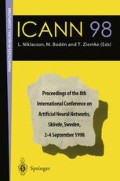Abstract
This paper presents a biologically inspired adaptive control architecture for a four-legged walking machine. In this architecture neural networks are used in two different aspects. First, simple recurrent neural networks are used as coupled neuro-oscillators to represent elementary periodic movements. Second, Radial Basis Functions are employed as state space representation for a Reinforcement Learning component, with which superimposing and coordination of elementary movements are learned. In the development of the presented architecture some results of research on mammalian locomotion are included. The architecture is used to model intralimb coordination of the four-legged walking machine BISAM
Access this chapter
Tax calculation will be finalised at checkout
Purchases are for personal use only
Preview
Unable to display preview. Download preview PDF.
References
A.G. Barto, R. S. Sutton, and Ch.W. Anderson. Neuronlike adaptive elements that can solve difficult learning control problems. IEEE Transactions on Systems, Man and Cybernetics, SMC-13:834–846, 1983.
T. G. Brown. On the nature of the fundemantal activity of the nervous centers. Journal of Physiologie, 1914.
M. Fischer and H. Witte. The functional morphology of the three-segmented limb of mammals and its specialities in small and medium-sized mammals. In European Mechanics Colloquium: Biology and Technology of Walking. Euromech 375, 1998.
R. Full. Opening lecture of the 1st Congress on Biomechanics Jena, Germany. BIONA Report, 1998.
W. Ilg, K. Berns, H. Jedele, J. Albiez, R. Dillmann, M. Fischer, H. Witte, J. Biltzinger, R. Lehmann, and N. Schilling. From small mammals to quadrupedal animats: Biologically inspired construction and control architecture for a four-legged walking machine. In From animals to animates: Fifth International Conference of the Society for adaptive Behaviour, 1998.
W. Ilg, Th. Mühlfriedel, K. Berns, and R. Dillmann. Hybrid Learning Concepts based on Self-organising Neural Networks for Adaptive Control of Walking Machines. Robotics and Autonomous Systems, 22(3):317–329, december 1997. Special Issue: Robot Learning — The new Wave.
K. Matsuoka. Mechanisms of frequency and pattern control in the neural rhythm generators. Biological Cybernetics, 56:345–353, 1987.
Author information
Authors and Affiliations
Editor information
Editors and Affiliations
Rights and permissions
Copyright information
© 1998 Springer-Verlag London
About this paper
Cite this paper
Ilg, W., Albiez, J., Jedele, H. (1998). A biologically inspired adaptive control architecture based on neural networks for a four-legged walking machine. In: Niklasson, L., Bodén, M., Ziemke, T. (eds) ICANN 98. ICANN 1998. Perspectives in Neural Computing. Springer, London. https://doi.org/10.1007/978-1-4471-1599-1_62
Download citation
DOI: https://doi.org/10.1007/978-1-4471-1599-1_62
Published:
Publisher Name: Springer, London
Print ISBN: 978-3-540-76263-8
Online ISBN: 978-1-4471-1599-1
eBook Packages: Springer Book Archive

